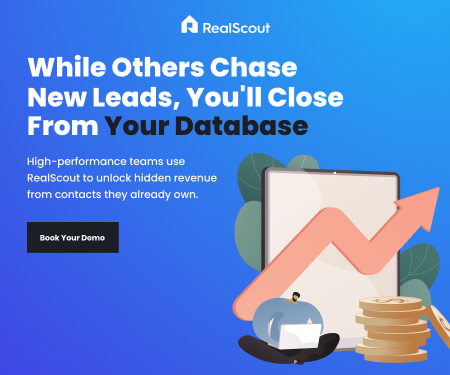The evening sun cast long shadows across Jennifer’s office as she studied the latest real estate market report. After three years of a blistering seller’s market in Portland, the numbers were unmistakable—inventory was climbing, days-on-market had doubled in just six months, and price reductions were becoming commonplace. The market shift was here.
Jennifer wasn’t panicking like some of her colleagues. Having weathered multiple real estate market cycles in her fifteen-year career, she knew exactly what to do. She opened her CRM and began implementing the database pivot she had planned for precisely this moment.
Key Takeaways
- Prioritize different database segments based on market conditions.
- Adapt your messaging to match current market realities.
- Monitor various behavioral signals in response to changing market conditions.
- Automate your systems to respond to market shifts.
- Prepare market transition plans before you need them.
When the Real Estate Market Tide Turns
Real estate is cyclical by nature—the blazing seller’s markets with multiple offers and waived inspections eventually cool. The challenging buyer’s markets with abundant inventory and cautious shoppers eventually heat up again. What separates consistently successful agents from those with feast-or-famine businesses isn’t luck—it’s how they adapt their database strategy to current conditions.
Many agents make the mistake of using the same database approach regardless of market conditions. But the homeowner who was hesitant to sell during a buyer’s market might be your best opportunity in a seller’s market. And the first-time buyer who couldn’t compete six months ago might be ready to pounce now that conditions have shifted.
Reading the Real Estate Market Signals
Before adjusting your database strategy, you need to identify the market you’re in accurately. While local conditions vary, specific indicators reliably signal market direction:
In a seller’s market, inventory typically sits below a three-month supply, homes sell above the asking price, and the average days-on-market drops below 30 days. Multiple offers become common, and buyers often waive contingencies to compete.
Conversely, a buyer’s market is characterized by inventory exceeding a six-month supply, price reductions becoming standard practice, and days on market stretching beyond 60 days. Seller concessions increase, and buyers gain significant negotiating leverage.
By the time most agents realize the market has shifted, the opportunity to pivot early has passed. Smart agents set up automated alerts in their MLS for any changes in days-on-market trends or months of inventory. When those metrics move more than 15% in either direction over a 60-day period, they trigger their market transition plan.
The Database Pivot: Adjusting Your Focus
When Jennifer noticed Portland’s real estate market cooling, her first action wasn’t calling clients—it was restructuring her database segments. She knew different contacts would become priorities in the new market reality.
Jennifer’s Seller’s Market Priorities Had Been:
- Equity-rich homeowners who could capitalize on peak prices
- Move-up buyers with significant equity who could leverage their position
- Investors looking to sell properties at maximum profit
- Past expired listings from previous buyer’s markets
However, with the shifting market, Jennifer’s new priority segments became:
- Pre-approved buyers who had been outbid repeatedly but remained motivated
- First-time buyers previously priced out of the market
- Strategic investors with cash ready to capitalize on reduced competition
- Motivated sellers facing life transitions requiring moves, regardless of market conditions
The contacts are all still in the database, but who you focus your time on and what you communicate changes dramatically with market conditions.
Tailoring Your Message to Market Realities
The core of successful database management isn’t just who you talk to—it’s what you say. As markets shift, so must your messaging.
Smart agents adjust their communication strategy based on real estate market conditions:
In a Seller’s Market:
Potential sellers receive messages highlighting rapid appreciation, low inventory in their neighborhood, and strategies for leveraging their equity position. They receive automated home value alerts monthly, showcasing rising values and including testimonials from clients who sold their homes above the asking price.
For buyers, messaging focuses on winning strategies in multiple-offer scenarios, the importance of pre-approval, and the cost of waiting as prices continue to climb. The content addresses concerns about waiving contingencies safely and shares success stories of buyers who secured homes despite intense competition.
In a Buyer’s Market:
Seller messaging pivots to emphasize marketing expertise that helps properties sell while others linger. Agents share their average days on market compared to MLS averages and provide guidance on strategic improvements with high ROI. The focus shifts to setting realistic expectations while demonstrating their advantage in challenging conditions.
For buyers, the messaging celebrates increased negotiating power, highlights opportunities for price reductions, and provides analysis of neighborhood trends. Content covers negotiating repairs and concessions effectively and shares case studies of recent buyers who secured exceptional value.
The contacts stay the same, but the conversation changes completely. When messaging matches market conditions, engagement rates can double compared to generic content.
Automating the Market Response
For teams managing thousands of contacts, manual adjustments to database communication aren’t feasible at scale. They need systems that can automatically adapt to changing conditions.
Kenny Truong of Fast Real Estate explains: “RealScout is the fastest and most cost-effective way to generate transactions from your CRM.”
Successful teams set up automated systems that adjust:
- The frequency of home value alerts based on market appreciation rates
- Which neighborhood market reports contacts receive based on current activity
- The types of properties highlighted in listing alerts based on days-on-market trends
- Which educational content is delivered based on market conditions
This systematic approach ensures relevant communication without requiring teams to manually adjust thousands of contact records. When market conditions change, they update a few master templates rather than rethinking their entire communication strategy.
Recognizing Different Signals in Different Real Estate Markets
The behaviors that indicate a lead is ready to transact also change in response to real estate market conditions. High-performance teams adjust which signals they prioritize based on current market realities.
In a seller’s market, a buyer viewing the same property multiple times within 48 hours is a strong signal—they’re preparing to move quickly before someone else grabs it. But in a buyer’s market, that same behavior might just be normal comparison shopping.
Similarly, the signals from potential sellers evolve with market conditions. In a hot seller’s market, someone checking their home value twice a month is often driven by curiosity about appreciation. But in a cooling market, that same behavior might signal serious selling consideration, especially if paired with viewing comparable sales in their neighborhood.
Successful teams adjust their monitoring systems to prioritize different behavioral triggers based on market conditions:
High-Intent Signals in a Seller’s Market:
- Multiple property views within a short timeframe
- Weekend property searches (indicating willingness to act quickly)
- Mortgage calculator usage (signaling financial preparation)
- Multiple open house registrations in the same weekend
High-Intent Signals in a Buyer’s Market:
- Repeated home value checks (potentially signaling selling consideration)
- Pattern of viewing price-reduced properties
- Engagement with content about home improvements (possibly preparing to list)
- Searches for expired or withdrawn listings (indicating sophisticated buyers)
Technology That Adapts to Market Conditions
The technology tools teams deploy should also flex with real estate market conditions. As Jennifer saw Portland’s market shifting, she reallocated her technology budget to address new priorities.
In a seller’s market, teams invest heavily in systems that help buyers compete, including instant alerts for new listings, automated offer generation, and pre-inspection scheduling tools. As the market cools, they shift technology investments toward extended marketing automation for listings, virtual staging platforms, and advanced CRMs for longer nurture sequences.
This flexible approach ensures that technology serves current market needs rather than becoming an expensive, legacy system that fails to address changing priorities.
The Human Element: Pivoting Personal Outreach
While automation and technology form the foundation of database strategy, personal connections remain crucial, especially during market transitions.
Strategic “transition calls” with key contacts when market conditions shift significantly prove valuable. These aren’t sales calls—they’re educational conversations about what’s changing in the market and how it might affect their specific situation. Rather than asking for business, they demonstrate value by helping contacts understand new market realities.
This approach typically generates listing opportunities within 30-45 days, even from contacts who weren’t previously considering selling. People appreciate honest guidance during shifts in the real estate market. Being the first agent to help them understand new real estate market conditions positions you as their trusted advisor when they’re ready to act.
Building Market-Adaptive Systems
For teams looking to implement market-adaptive database strategies, the process doesn’t happen overnight. The most successful teams develop their approach over several market cycles, gradually building systems that can pivot quickly when conditions change.
Their framework includes:
- Market trigger definitions: Specific metrics that, when reached, automatically initiate market transition protocols
- Segmentation templates: Pre-built database segments that can be quickly implemented for different market conditions
- Content libraries: Market-specific messaging ready to deploy when conditions shift
- Training protocols: Team education processes to ensure consistent messaging during transitions
- Database health initiatives: Regular cleaning and enhancement of contact information to maintain readiness regardless of market conditions
The key is preparation before you need it. If you wait until the market has already shifted to develop your strategy, you’ve missed the opportunity to lead rather than follow.
Real Results from Market-Adaptive Strategies
Jason Wright of Coldwell Banker Time Smith Group experienced the power of effective database engagement firsthand: “Within just 24 hours of implementing RealScout, the level of engagement was astounding—nearly 700 people interacted with my instance of RealScout. By the 48-hour mark, RealScout helped me land several meetings… including a listing appt for a $3M property.”
Similarly, Gigi Lopez of Kasakane saw immediate results from systematic database nurturing: “I’ve added a little over six hundred contacts to the database. I’ve set them up on Home Value and Market Activity Alerts… From the past month, I’ve had two listings come from that.”
These results demonstrate that with proper systems and market-adaptive strategies, databases can consistently generate opportunities regardless of market conditions.
Conclusion: Database Fluidity Equals Real Estate Market Resilience
As Jennifer implemented her database pivot in Portland, she reflected on how different this transition felt compared to previous shifts in the real estate market. Rather than anxiety, she felt prepared. Rather than scrambling to react, she was methodically executing a pre-planned strategy.
The real estate professionals who thrive through changing market conditions aren’t necessarily the ones with the biggest databases or the most expensive technology. They’re the ones who have built flexible, responsive systems that can quickly adapt to new market realities.
By prioritizing different segments, adjusting messaging, monitoring market-appropriate signals, and deploying the right technology tools for current conditions, these market-adaptive agents maintain steady transaction volume while their competitors struggle with the transition.
Your database isn’t just a list of contacts—it’s a dynamic ecosystem that should evolve in response to market conditions. The question isn’t whether the market will change, but whether your database strategy is ready when it does.






